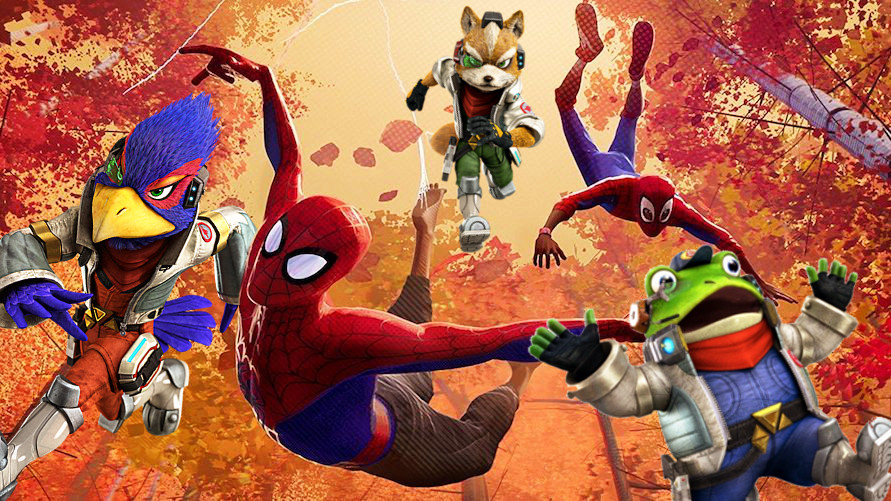
This December, I saw Into the Spider-Verse, twice. It’s an incredible film, one of the best animated movies I’ve ever seen, and definitely one of the most narratively dense. Like, seriously y’all, this movie does A LOT in two hours. As someone who chronically struggles with overwriting, I promptly tracked down the screenplay and studied it like a sacred scroll.
At the same time, I spent a few weeks in December taking a break from more serious projects to bang out a screenplay based on the Star Fox series (which you can read here!) It’s a franchise I have a lot of affection for, and I wanted to learn how to structure a blockbuster family script.
Between reading Spider-Verse, writing Star Fox, stewing over story structure, and cranking out 10-15 pages a day, it was an insanely instructive December. I learned a great deal about the craft of screenwriting — but in particular, I learned one new skill that has utterly changed how I approach breaking a story.
Scene Smashing
When I say Spider-Verse does a lot in two hours, what I really mean is, a lot happens at once, in every single scene. For example, here’s a list of story beats:
- Miles doesn’t know how to webswing
- Peter doesn’t like or trust Miles
- Peter and Miles break into a facility to steal an important computer
- A new villain, Olivia Octavius, is introduced
- Peter and Miles run from some bad guys (action scene)
- Olivia is too strong for Peter and Miles to handle
- Peter tries to tutor Miles in webswinging and fails
- Miles learns to webswing on his own, by ignoring Peter and trusting his instincts
- A new protagonist, Gwen Stacey, is introduced
I’m being slightly pedantic here, for effect, but still. That’s quite a list! In a lesser movie, that could be nine separate scenes. A half hour of screentime.
In Spider-Verse, it’s this:
The whole sequence that includes that clip is about 10 pages in the script. On screen, I think it takes about 8 minutes. And in that time, it hits every one of those beats in the list above.
That’s incredible. Seriously. That kind of narrative density is very, VERY difficult to achieve. (I mean for heaven’s sake, I’ve seen other Marvel movies that spend 5 minutes on two people having a fist-fight, with almost nothing else going on).
So how does the movie accomplish all that?
By just having everything happen at once.
Here’s that same list of story beats, smashed together into two scenes:
- Peter and Miles bond while breaking into a facility to steal a computer from a scary new villain who chases them out
- Miles teaches himself to webswing while they flee, until Gwen Stacy arrives to rescue them
I’ve heard this kind of thing called “condensing scenes” before, but that doesn’t feel sufficient to describe what’s being done here. “Condensing scenes” is an act of clinical surgery, reserved for a piece of writing that’s already complete, and has come in too long. “You have too many scenes. We’re going to bring in a specialist to condense them. She’ll make incisions here, here, and here…”
Scene smashing, on the other hand, is a BEFORE process. It comes during the outline phase. It’s looking at a list of story beats and asking: What if these just happened simultaneously? What would that look like? What if instead of exposition followed by a chase scene, we just did exposition during a chase scene?
Well, you get stuff like this:
Regardless of your opinion on Force Awakens as a whole, it’s hard to deny this scene bangs pretty hard. And it hits four big story beats that could have been four whole scenes (finding the Falcon, stealing the Falcon, Finn and Rey learning to work together, escaping Jakku) in one exciting sequence.
Scene smashing is a small idea, but pretty revolutionary once you start applying it. It tightens the pace, cranks the audience engagement to 11, lets every other sequence be a full-throttle banger, and results in some really unique moments where one line of dialogue can throw eight plot-levers at once. I leaned on it heavily while writing my Star Fox script, and I can say without shame that it’s one of the tightest, most confident pieces of screenwriting I’ve ever produced.
Hell, I even found myself doing it while writing, which is a damn sea-change for a chronic overwriter like me. I’d get halfway through a scene and think “You know what? I can fold the next scene into this one right now and save myself five pages.” And every single time I did it, both scenes improved exponentially.
Going forward, I’ll be applying a scene-smashing mindset during the outline phase on any new project. And if you’re thinking about doing the same, here’s an exercise for you:
Pick two back-to-back scenes in the last movie you watched. If you smashed them together into one, what would it look like?